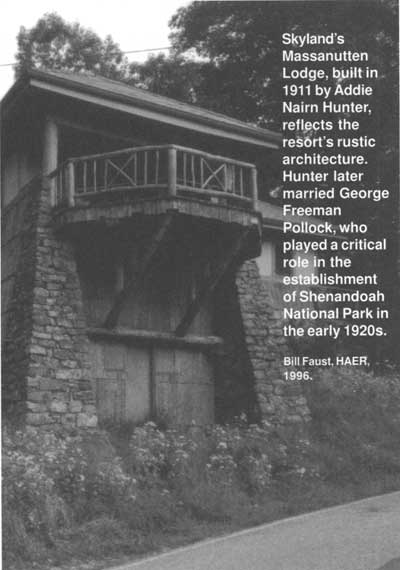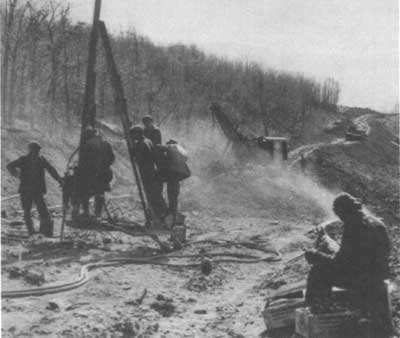 | ||
 | ||
 | ||
 | ||
 | ||
 | ||
 | ||
 | ||
 | ||
 | ||
 | ||
 | ||
 | ||
 | ||
 | ||
 | ||
 | ||
 |
 |
 |
Shenandoah National Park
SKYLINE DRIVE
Virginia

Skyland's Massanutten Lodge, built in 1911 by Addle Nairn Hunter, reflects the resort's rustic architecture. Hunter later married George Freeman Pollock, who played a critical role in the establishment of Shenandoah National Park in the early 1920s. —Bill Faust. HAER 1996 |
LYING LIGHTLY ON THE LAND
|
"Last Wednesday, for the first time, I
completed the final length of that glorious new drive of yours along the
crest of the Blue Ridge ... The President and I extend our heartiest
congratulations to you and your department in so workman-like a job and
so splendid a work of natural art."
—Mrs. Lou Henry Hoover to NPS
Director Horace Albright, Dec. 6, 1932
|
NPS landscape architects drew upon the naturalistic landscape gardening practices of the 1920s, and their own previous experience in western parks as they designed Skyline Drive to lie lightly along the crest of the Blue Ridge Mountains. This was accomplished through an extensive program of landscape naturalization and road beautification that blended the drive into its surroundings and prevented road-side soil erosion. Banks and cut crests were rounded, slopes flattened, and the ends of cuts and fills warped to thoroughly integrate the new surfaces with the old. The CCC performed much of the road bank blending along the drive using power shovels to cut back the slopes, then rounding them with hand labor. Topsoil that had been stripped away and stored during road construction was reapplied to the shoulders and banks. The slopes were revegetated with native plants in naturalistic planting patterns.

Skillfully crafted masonry work of native stone frames the rock outcropping at Hazel Mountain Overlook in the park's Central District. This stone masonry characterizes the drive's drop inlets, tree wells and fountains.—Shane Wirth, HAER |
|
"We worked and we felt like men."
—Torrey Best, Civilian
Conservation Corps
enrollee, NP-2, Big Meadows |
Many of the trees and shrubs were salvaged and transplanted from construction areas or abandoned farmsteads within the park. Vines, such as Virginia creeper, wild grape, American bittersweet, and clematis were rooted in rock cuts and along guard walls. Road banks and overlooks were planted in mountain laurel and other small shrubs, or seeded with grasses, ferns, annual and perennial wild flowers. In developed areas, the addition of trees and shrubs provided proper visual aesthetics. Planted meadows and open bays varied the forest outline along the roadside, while artificially trimmed vistas opened spectacular views from the drive and overlooks.

This 1934 photograph of excavation and grading operations in the North District is typical of the drive's construction. Controlled blasting techniques minimized unsightly landscape scars and conserved stone for construction uses.—SHEN |
| Introduction | Acadia | Blue Ridge Parkway | Chickamauga and Chattanooga | Colonial Parkway | Generals Highway | George Washington Memorial Parkway | Great Smoky Mountains | Mount Rainier | Rock Creek and Potomac Parkway | Shenandoah's Skyline Drive | Southwest Circle Tour | Vicksburg | Yellowstone | Yosemite |
